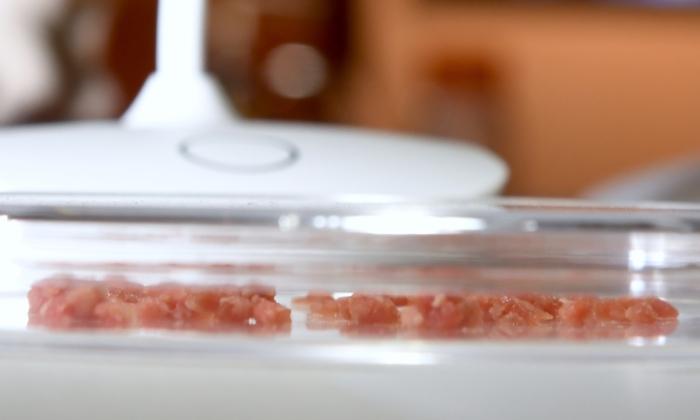Lab grown “meat” may be potentially worse for the environment than actual beef and may have an even larger carbon footprint, according to a recent study.
This follows the USDA’s approval of the FDA’s decision on June 21 to greenlight the sale of lab-grown meat to American consumers.
Advocates of lab grown meat, which is cultured from animal cells, has been lauded by activists of being more environmentally friendly than beef, as it uses less land, water, and produces no greenhouse gases, compared to raising cattle.
The United States joins Singapore as the only country approving “cell-cultured” meat for human consumption
Only chicken has passed the official government approval process for now, with a “no questions” letter that grants permission for distribution, but pork and beef will have to wait.
Fake Meat May Actually Require More Energy Than Organic Meat
Amy Quinton from UC Davis Department of Food Science announced preliminary results from the study on the environmental impact of lab grown meat in a May 22 report.The researchers assessed the amount of energy needed and the greenhouse gases emitted to create artificial beef and compared it with traditional organic meat production.
It was found that scaling up production using current lab methods was highly energy intensive.
Lab-grown meat is produced through the use of highly refined or purified growth media, which are the ingredients used to make animal cells multiply and is similar to how biotechnology firms make their drugs.
“If companies are having to purify growth media to pharmaceutical levels, it uses more resources, which then increases global warming potential,” stated UC Davis doctoral graduate Derrick Risner, the study’s lead author.
“If this product continues to be produced using the ‘pharma’ approach, it’s going to be worse for the environment and more expensive than conventional beef production,” he added.Researchers Hope to Make Artificial Meat Production More Energy Efficient
The UC Davis Cultivated Meat Consortium, which led the study, are a group of scientists, engineers, entrepreneurs, and educators researching lab grown meat.The artificial meat industry plans on creating lab-grown meat using primarily food-grade ingredients or cultures, that use less energy-intensive pharmaceutical grade ingredients and processes in the future.
They hope that improvements in developing the technology, through “pharma to food,” will perfect the production of artificial meat products.
Other goals include the establishment and evaluation of cell lines that could be used to grow meat and to improve the structure in cultured meat.
Me. Risner stated, that if lab-based meat failed to create a more climate-friendly burger, there is still valuable science to be learned from the attempt.
“It may not lead to environmentally friendly commodity meat, but it could lead to less expensive pharmaceuticals, for example,” he added.
US Production Has Begun
Only a few places will be producing cell-cultured meat for public use for now.Upside Foods and Good Meat, of California, will first be distributing their product at Bar Crenn in San Francisco and celebrity chef José Andrés’ restaurant, China Chilcano, in Washington, D.C.
China Chilcano will first serve Good Meat’s “Anticuchos de Pollo” on the week of July 31 as part of an exclusive tasting menu at $70 per person, by reservation only and then only available in very limited quantities.
Artificial meat will have the words “cell-cultured” written on the tag.
The two firms say that their artificial chicken meat will emit 92 percent fewer carbon emissions and use 95 percent less land during production.
“Bioreactors and the supporting infrastructure required to produce cultivated meat are not inexpensive to design, build and operate,” said the spokesperson, comparing the technology to the electronics industry where “costs will drop over time.”
Good Meat said a few more steps need to be made before that prices will drop.
The spokesperson said their lab was focused on improving the process to increase cell density, design larger-scale containers to grow meat, and creating more affordable and efficient nutrients to feed the cells.
Risner told Townhall that the lab meat industry would benefit from the creation of a supply chain for amino acids that could expand current manufacturing volumes.
“It will take a significant amount of time to reach mass commercial production,” the spokesperson continued.
Once cell-cultured meat hits mass production, Good Meat believes that sales will pick up as the public becomes more aware of the product.
The spokesperson said that the dishes sold in Singapore have already received universally high marks from diners, after gaining regulatory approval in the island nation in late 2020.





